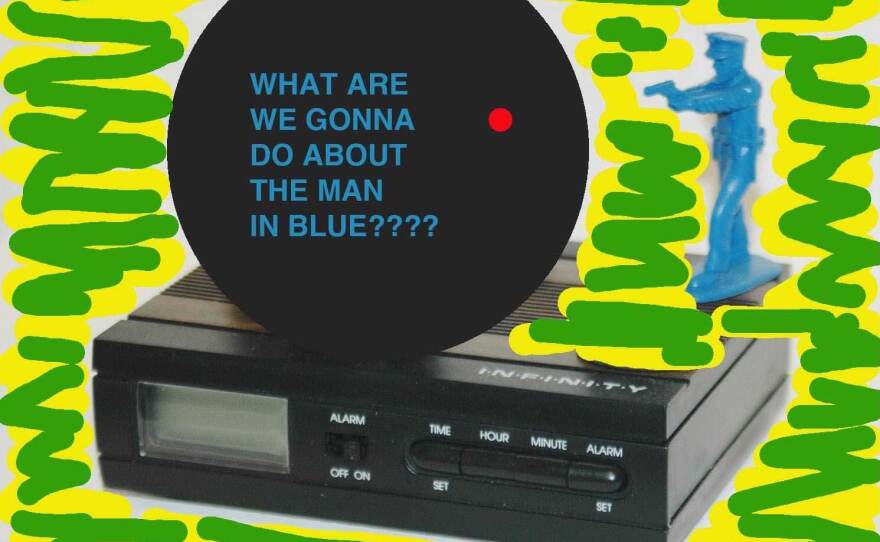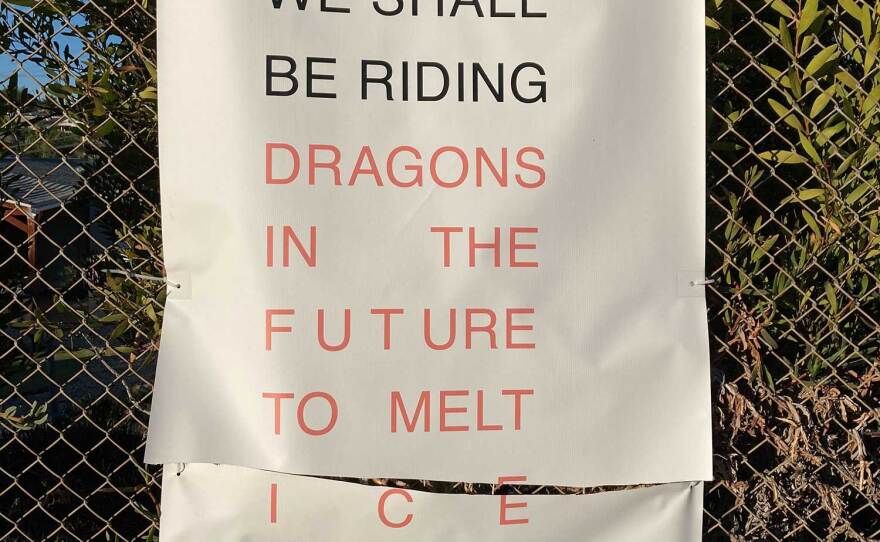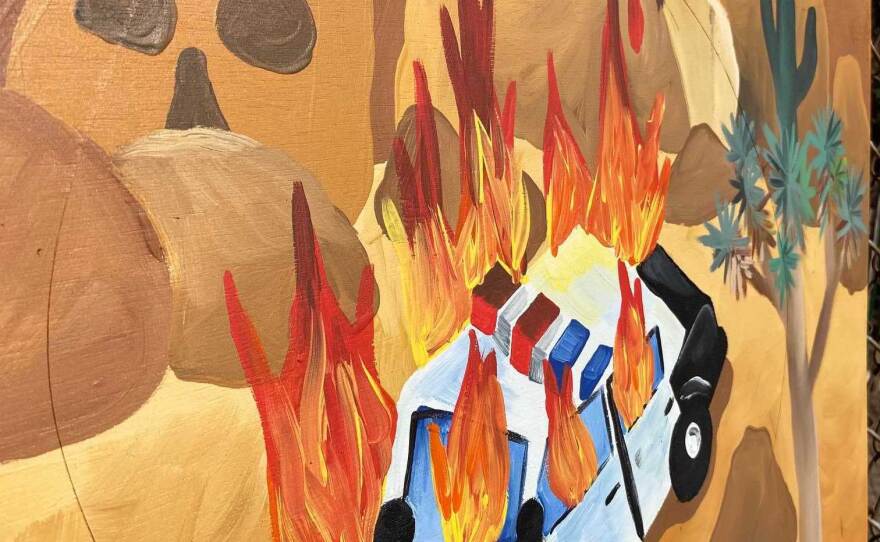Three works of art were damaged last week, and the artists and curator believe they were intentional acts of vandalism.
"Whoever it was — I don't know if it was one person, more than one person — they were targeting certain works," said Alessandra Moctezuma, professor of fine arts and museum studies and the gallery director at San Diego Mesa College.
Mesa College Art Gallery's new drive-thru art exhibition opened for a limited run in mid-November. Designed to share art with the community while indoor museums and gallery spaces are mostly closed, the pieces were installed with zip-ties from a chain-link fence on the north end of campus. The majority of the works are prints on durable weather-proof material, but some are original paintings and textile works. The parking lot setting provided a way for both vehicles and pedestrians to browse the works.
RELATED: Mesa College’s Drive-Thru Exhibition Innovates Art And Education
The college, part of the San Diego Community College District, has a museum studies program that attracts students of all levels and showcases art from both established and emerging artists. Moctezuma's students designed, curated and installed this exhibition this semester.

Residents in the neighborhood around Mesa College first noticed damage last week and reached out to KPBS, and the Mesa College Police Department had been notified.
The three damaged works include messaging about policing or immigration law enforcement.
One piece, Scott Gengelbach's "Shot in the back," is a digital image featuring a collage of a toy police officer pointing a gun. A circle in the middle includes the text "What are we gonna do about the man in blue????" The entire text circle was cut out of the work with a blade.

"When you have a dialogue in a public or semi-public space, you do open it up to a very wide audience and not everybody who's going to see the work is going to agree with you. And then some people are going to want to express themselves more strongly," Moctezuma said. "I don’t get so upset about it because I feel that what it points to is that we have to have more of a dialogue and communication about these issues. I think if we just get upset then we kind of shut it out."
John Calavitta-Dos Santos' piece, "We shall be riding dragons in the future to melt ICE" was also damaged. It's a text-based piece, a simple all-caps, sans-serif font in red and black ink. Calavitta-Dos Santos is a Long Beach-based poet and writer.
This particular work was inspired by his husband's plight as an undocumented worker, as well as the history of Stonewall and other barriers faced by the LGBTQ+ community, including potential arrest for being gay.

"So just from my community standpoint, I’ve always been sort of suspicious of the police state that we live in," Calavitta-Dos Santos said. "There is a huge class of people in this country that are considered expendable and throwaway and constantly targeted."
His piece was slashed into two pieces across the word "ICE."
"I've seen histories of art where art was attacked so I know it through sort of intellectual history, art history, but it's never happened to me," Calavitta-Dos Santos said. "To look at the positive, I think it means that people are reacting to art, which is a good thing. That the art has a message. When art is attacked, that means it's having an effect. People are coming up against that idea."
Moctezuma is having new prints made of the Gengelbach and Calavitta-Dos Santos works. For now, the team added new fasteners on Calavitta-Dos Santos' damaged piece to secure it to the fence, and Gengelbach's damaged work remains on view.

The third damaged piece is an original painting, not a print. "The World on Fire" by Katie Carrion is acrylic on wood panel and features a woman seated at a campfire in the desert. In the background, distant mountains and a police patrol car are also on fire.
"I painted it specifically for this show knowing that the show would be opening the same week as the election results. I wanted to make a painting about climate change and police brutality, two subjects that I'm passionate about and I think we have major problems with in this country," Carrion said.

The piece is cut around the police car, and Moctezuma believes that the person tried to cut out a circle like in Gengelbach's work. But since it is mounted on wood, they were unable to cut through. The piece fell from its fasteners, though, and was found hanging upside down.
"It's no surprise to me that my painting was vandalized. I almost expected it, knowing that my painting would be in public view for about a month," Carrion said. "It's very sad to me but I'm happy that my painting evoked some feelings. And to me that's success, that's what art is about. It's not always making pretty paintings that will please everybody, but speaking about what's really going on."
For now, Moctezuma removed this painting to prevent further damage, and a print will be made for the remainder of the exhibition, which closes December 9 and is on view Monday through Friday from 8 a.m. to 4 p.m.
In the spirit of the original exhibition, it has become a learning opportunity for the student curators. "You're learning about what happens when you put art out in a public space. It's very different for somebody to choose to go into a gallery or a museum, to have that choice to look at something they're interested in," Moctezuma said.
"In this case, we’re putting the work outside, so you’re going to have all kinds of folks coming through," Moctezuma said. "Somebody wanted to comment."






